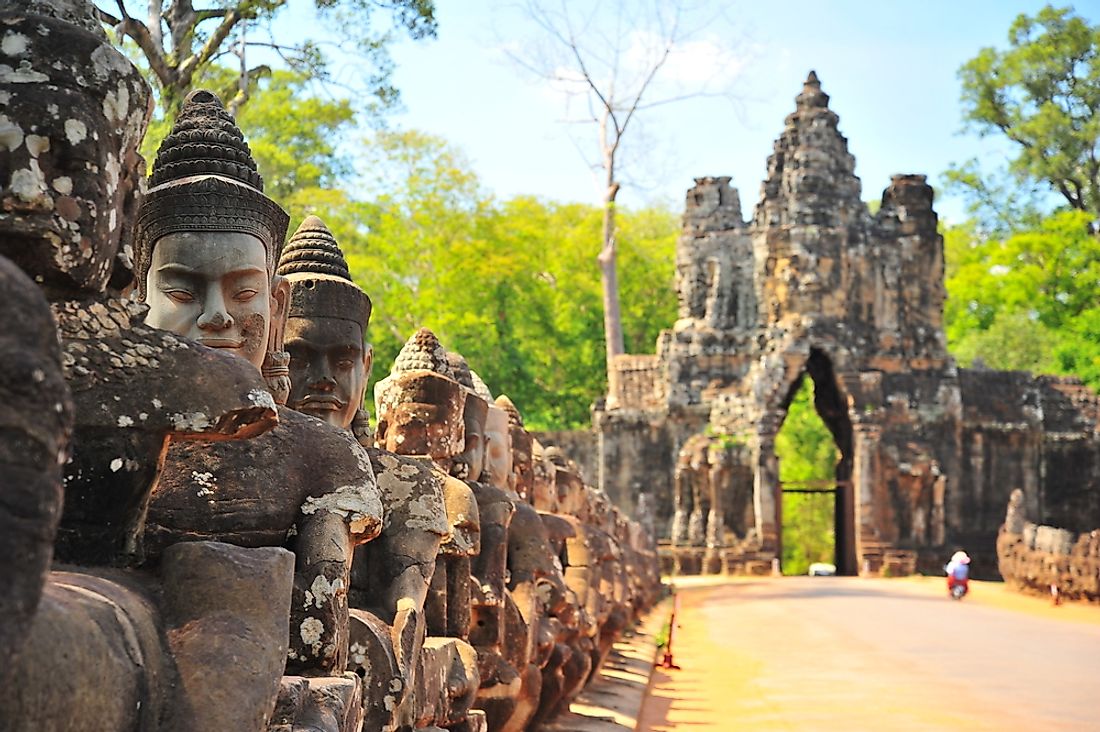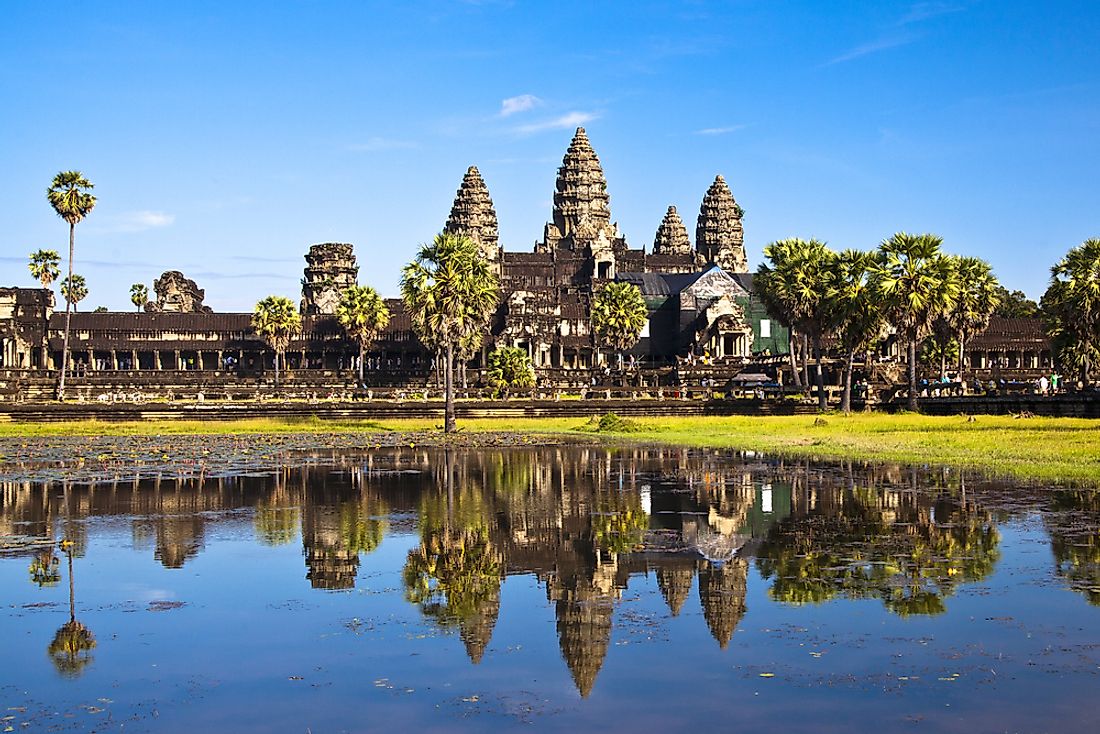The Top 10 Tourist Attractions In Cambodia

Cambodia is a small country located in the Indochina Peninsula's southern portion in Southeast Asia. The country is bordered by Vietnam, Thailand, and Laos. It also has a coastline along the Gulf of Thailand to the southwest. Cambodia has a well- developed tourism industry as tourism is one of the most important sectors of the country's economy. The country has a rich and inspiring history evident by the presence of magnificent temples and other structures from the past empires that ruled the region. Cambodia is also famous for natural attractions and unique biodiversity. Below is a sampling of ten of the most visited attractions in the country.
10. Siem Reap

Siem Reap is the capital city of Cambodia’s Siem Reap Province. The city is visited by millions of tourists each year as it serves as the gateway to the Angkor Wat. The city also has attractions of its own including colonial and Chinese-style buildings, museums, cultural villages, traditional handicraft shops, silk farms, and more. The Apsara traditional dance performances are also a popular attraction for tourists visiting Siem Reap. Siem Reap hosts a number of resorts, hotels, and restaurants to accommodate the large numbers of tourists visiting the city throughout the year.
9. Preah Vihear Temple

The Preah Vihear Temple is another temple tracing its origins to the Khmer Empire. The beautiful temple is located on a 525- meter tall cliff in the Dângrêk Mountains in the province of Preah Vihear. The temple offers the most spectacular view among all the temples built during the Khmer rule in Cambodia. The Preah Vihear was inscribed as a UNESCO World Heritage Site on July 7, 2008.
8. Sihanoukville

Sihanoukville is a coastal Cambodian city and the capital of the country’s Sihanoukville Province. The city’s coast borders the Gulf of Thailand. The city is famous for its almost uninterrupted stretch of beaches and the coastal marshlands with its unique biodiversity. The Ou Trojak Jet is the only navigable river in Sihanoukville. The city is a relatively young one in the history of Cambodia as it developed in parallel with the Sihanoukville Autonomous Port construction. Currently, it is a leading center of commerce and industry in the country. The city is also popular among tourists who enjoy the beaches and islands of the city. It is steadily developing into the country’s premier beach destination.
7. Tonlé Sap

Tonlé Sap refers to a wetland area comprising of the Tonlé Sap Lake, a seasonally inundated freshwater lake, and a 120 km long river, the Tonlé Sap River. The Tonlé Sap is thus a part of the vast floodplain of the Mekong River. The water volume of the lake varies significantly throughout the year. The lake and the river support diverse inter-connected ecoregions and a great amount of biodiversity. At least 149 fish species including 11 threatened species are housed here. A large number of migratory birds also visit the wetland. Some of the most notable birds seen here include the spot-billed pelican, the greater adjutant, Bengal florican, the grey-headed fish eagle, etc. The Tonlé Sap also hosts a significant population of several reptile species including many species of freshwater snakes. The Mekong giant catfish, one of the world’s largest freshwater fish, lives in the Tonlé Sap. Due to its ecological significance, the region has been designated as a biodiversity hotspot and a UNESCO biosphere reserve in 1997.
6. Silver Pagoda

Known by the official name of Wat Ubosoth Ratanaram, the Silver Pagoda is located on the Royal Palace’s south side. The pagoda houses magnificent statues of Buddha. Among the statues, the most famous one is a small, green crystal Buddha statue and a life-size gold statue of the Maitreya Buddha. The latter weighs around 90 kg and is decorated with 9584 diamonds. The Silver Pagoda is also inlaid with over 5,000 silver tiles and Italian marble structures on its outer facade. The Silver Pagoda currently serves not only as a tourist attraction but also its grounds are being used for various royal and national ceremonies of the country.
5. Bokor Hill Station

The Bokor Hill Station was once a popular hill station for French colonists in Cambodia. The hill station is located at the top of the Bokor Mountain in the Preah Monivong National Park. It is now a ghost town that is popular amongst tourists, as it features several French colonial buildings including a royal residence, church, casino, and hotel. In the early 1920s, the French colonists would enjoy the hill station as a luxury summer retreat. Today, modern buildings have come up in the region and several films like the City of Ghosts (2002) and the R-Point (2004) have been filmed here.
4. Kratié

Kratié is a small town located in eastern Cambodia and is the capital of the Kratié Province of the country. The town houses a population of about 38, 215 people and is located on the banks of the Mekong River. Many people visit this quiet and peaceful Cambodian city to enjoy its scenic beauty and unique culture. The central marketplace of the city is surrounded by French colonial structures. Big islands with white sand beaches are located on the Mekong flowing by the town. If one is lucky, one can get a rare sighting of the critically endangered Irrawaddy dolphins in the Mekong River near Kratié .
3. Koh Ker

For the more adventurous tourists visiting Cambodia, Koh Ker is a perfect choice. Unlike the temples of Angkor Wat, the temples of Koh Ker are dispersed within dense forests with little human population in and around the site. Koh Ker is a remote archeological site in northern Cambodia about 120 km away from the city of Siem Reap. Of the many monuments present here, only about two dozen are visited by tourists. The rest of the temples are hidden under dense overgrowth or are too dangerous to be accessed because of the presence of land mines in the area. Koh Ker was one of the most significant settlements during the Khmer rule. It briefly served as the capital of the Khmer Empire during the rule of the kings Jayavarman IV and Harshavarman II. Jayavarman IV contributed the most towards the development of the site and had a water tank and 40 temples constructed here during his rule. The Koh Ker has been a part of the UNESCO tentative world heritage list since 1992.
2. Banteay Srei

The Banteay Srei is a Cambodian temple that is often praised as the "jewel of Khmer art.” It is extremely popular among tourists who visit the site to marvel at its beauty. The Banteay Srei is a temple of the 10th century that is located near the Phnom Dei hills in the Angkor area. The temple is dedicated to Lord Shiva, a Hindu god. Built of red sandstone, the building is elaborately carved.
1. Angkor

Angkor was the Khmer Empire’s capital city that flourished between the 9th and the 15th centuries. During its peak in 1010 to 1220, Angkor was a megacity that supported 0.1% of the global population. Today, the city is in ruins but is most famous for the grand Hindu temple complex of the Angkor Wat. The picturesque ruins of Angkor are nestled amid forests and farmland near the Siem Reap city of Cambodia. Over 1,000 temples are located here ranging in size from piles of rubble amidst the rice fields to the magnificent Angor Wat, the world’s largest single religious monument. The entire architectural complex has been designated as a UNESCO World Heritage Site and is visited by millions of tourists each year.











